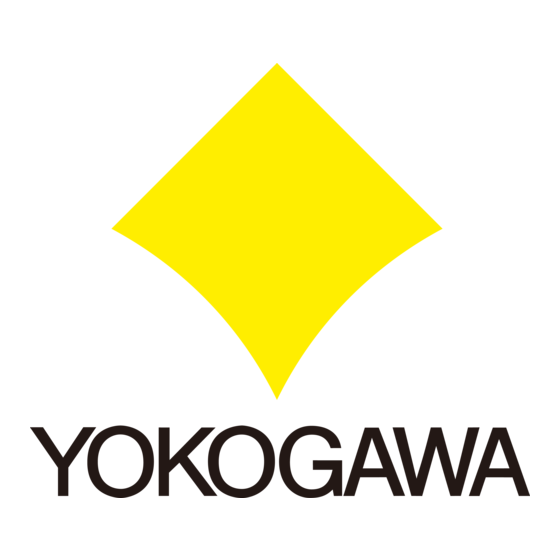Table of Contents
Advertisement
Quick Links
Download this manual
See also:
Instruction Manual
Advertisement
Table of Contents

Summary of Contents for YOKOGAWA SA11
- Page 1 Start-up Model SA11 Smart Adapter Manual IM 12A06S01-01EN-P 2nd edition...
-
Page 2: Table Of Contents
2-2. Warning and Disclaimer 2-3. SA11 2-4. Product Disposal 2-5. Warranty and service 2-6. Copyright and Trademark Notices 2-7. SA11 fonts 3. CE marking products 3-1. Authorized Representative in EEA 3-2. Identification Tag 3-3. Users 4. Introduction and general description 4-1. -
Page 3: Introduction
If sensors without ID-chip are connected, all calculated output data of the SA11 will be disabled. The SA11 Smart Adapter can be used in a system with other peripherals. Please refer to their belonging User Manuals for correct installation and correct working. -
Page 4: Safety Precautions
• If any protection or safety circuit is required for the system controlled by the product or for the product itself, prepares it separately. • Be sure to use the spare parts approved by YOKOGAWA when replacing parts or consumables. -
Page 5: Sa11
2-3. SA11 • The SA11 should only be used with equipment that meets the relevant IEC, American, Canadian, and Japanese standards. YOKOGAWA accepts no responsibility for the misuse of this unit. • The Instrument is packed carefully with shock absorbing materials, nevertheless, the instrument may be damaged or broken if subjected to strong shock, such as if the instrument is dropped. -
Page 6: Copyright And Trademark Notices
FLEXA, FLXA, SENCOM and FieldMate are trademarks or registered trademarks of YOKOGAWA Electric Corporation. Adobe, Acrobat and Acrobat Reader are either registered trademarks or trademarks of Adobe Systems Incorporated in the United States and/or other countries. -
Page 7: Ce Marking Products
This product is designed to be used by a person with specialized knowledge. 4. Introduction and general description This Quick Start-up Manual describes how to use SA11 with YOKOGAWA ’s HOST systems and sensors. Please read carefully this manual and the instruction manual of the relevant HOST system and sensor before using this SA11 slave device. -
Page 8: Checking The Accessories
4-3. Checking the accessories Make sure that besides the SA11 device the accessories in Table 1.1 are included. Options are available only if ordered. Table 1.1: Accessories Product Name Quantity Remark SA11 Smart Adapter dust caps 2 pcs/device To prevent dust inside the connectors... -
Page 9: Model And Suffix Code
SA11 Figure 5.1: Installation diagram SA11 5-1. Installation site The SA11 is weatherproof and can be installed both inside and outside. Select an installation site that meets the following conditions: • Mechanical vibrations and shocks are negligible • No relay switch and power switch are installed close to the device •... -
Page 10: Connecting To The Sensor
Place the Variopin connectors securely to guarantee IP67. Cable mounting When there is less room to install the SA11 on top of the YOKOGAWA labelled sensor or when the process conditions are higher than +100°C (for power supply +2.7 to +4.5VDC) or +125ºC (for power supply +4.5 to +5.5VDC), an alternative mounting method is to install the... -
Page 11: Wiring To The Host System
YOKOGAWA Bluetooth device model IB100. Interconnection in between the IB100 and SA11 is done using the WU11 type -S interconnection cable with at both ends a M9 connector. The wireless communication in between the Fieldmate system and IB100 is limited to a distance of 10 meter. - Page 12 When all wiring is completed, turn on the power of the HOST system. Part of the setup of the SA11 will be done automatically by reading the content of the ID-chip of the sensor. These are sensor characteristics, factory calibration data, customer calibration data, diagnostics and loggings of calibration and events.


Need help?
Do you have a question about the SA11 and is the answer not in the manual?
Questions and answers